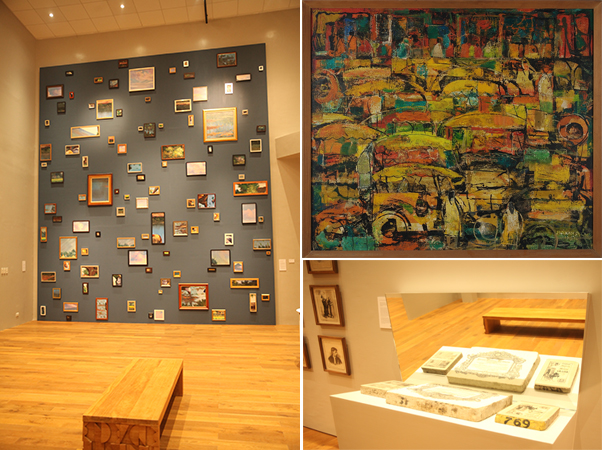Ateneo Art Gallery: ‘Nourished by the goodness of others’


Lance Gokongwei and Elizabeth Gokongwei(left) Paulo and Pilar Lorenzo, Isa Lorenzo, Alice Lorenzo, Millet and Tomas Lorenzo(right)
Last Feb. 18, the Ateneo Art Gallery (AAG) formally welcomed the public to its new home at Areté, showcasing three different shows in all of its three floors. While it had opened its doors late last year with an exhibition featuring the works of Ateneo Art Awards finalists as well as of previous winners in the show, “Mutable Truths,” it was the first time that the gallery, considered as the first modern art museum in the Philippines, makes full use of all its exhibition spaces and presents the richness of its permanent collection.
Specifically located at Arts Wing, the building evoked through an expressive silhouette tempered by diagonal lines and visible from Katipunan Avenue, AAG takes pride in its role as the home of modern and contemporary art, as expressed by the works located in the upper ground galleries: the Mr. and Mrs. Chung Te Gallery, the Mr. and Mrs. Ching Tan Gallery, and Ernesto and Susan Tanmantiong Gallery. Some of the most notable works in Philippine art history are here: from Jose Joya’s “Granadean Arabesque” to the key works of Social Realism to videos and installations of the current decade.
Those who already visited the gallery (a good two to three hours may be devoted to the upper ground galleries alone) may be surprised to learn that the works exhibited comprise of just 20 percent of the total collection. “There are many big pieces in the collection,” says Ma. Victoria “Boots” Herrera, director and chief curator of the gallery. “I guess that’s the reason we can only show 20 percent. More or less, this would be the maximum at any given time. Otherwise, it would be very crowded.”

Exhibited at the Sharjah Biennale, the work of the husband-and-wife Alfredo and Isabel Aquilizan, “The Mabini Projects,”(left) is now part of the permanent collection of the Ateneo Art Gallery. One of the prized pieces of the AAG collection is Vicente Manansala’s “Jeepney,”(upper right) which the
National Artist painted in 1951. The lithograph stones (lower right) donated by the Ramos family of the National Book Store.
Titled “Love It and Leave It,” the inaugural exhibition “aims to highlight the role of philanthropy which not only sustained the growth of the AAG but also made possible the realization of the newly constructed Areté.” The gallery, in fact, began when Fernando Zobel bequeathed his art collection to the university, possibly the biggest donation of its kind. “This gift is an unconditional one,” Zobel wrote in a letter dated Jan. 11, 1960 to the then Ateneo president and rector Fr. Francisco Araneta SJ. “I want the Ateneo to have a complete freedom in the use of these pictures.” Current president Fr. Jose Ramon “Jett” Villarin gestures to this largesse when he said: “We are not just what we earned and worked hard for. We are what we have received from the goodness, the ‘arete’ of others.”
For a year, the donations, divided into decades, will be rotated to ensure that all works will be exhibited and all donors of about 150 individuals and institutions represented. While Herrera knows the breadth and depth of the collection, she was still surprised to see an early Prudencio Lamarroza, a set of David Medalla drawings donated by the art critic Leo Benesa, and a huge work by Rodel Tapaya which the artist donated himself. What is proving to be a crowd favorite is Alfredo and Isabel Aquilizan’s “The Mabini Project.” “They were the ones who chose the space,” says Herrera. “I was really happy the way they mounted it here. At the Sharjah Biennale, it was different. It’s nice to have variations of how it can be installed.”
Herrera acknowledges the work done by the first curator of AAG, Emmanuel “Eric” Torres, who extensively collected works by Social Realist artists, adding to the post-war modern pieces of the Zobel bequest. “I think Eric Torres defined a clear path for the collection,” she says. Because of this focus, it is much easier to determine and fill the gaps, which are mostly the conceptual pieces from the ‘60s and the ‘70s and abstractions from the ‘80s and the ‘90s.
Temporarily addressing this gap of conceptual pieces is the show, “The 70s: Objects, Photographs & Documents” at the Elizabeth Gokongwei Gallery, Ambeth R Ocampo Gallery, and Alicia P Lorenzo Gallery, which will run until July 2. Guest curated by Ringo Bunoan, the exhibit highlights “practices in the 1970s that have often been marginalized in art historical texts and narratives,” such as those of featured artists that include Roberto Chabet, Raymundo Albano, Huge Bartolome, Joe Bautista, Danilo Dalena, Joy Dayrit, Nath Gutierrez, Nap Jamir, Johnny Manahan, Red Mansueto, Fernando Modesto, Butch Perez, Yolanda Perez-Johnson, and Judy Sibayan.
“Objects, Photographs & Documents” kick-starts AAG’s new exhibition program series, “Philippine Art by the Decade” whose aim is “to explore new perspectives in Philippine art history” by inviting a guest curator “to organize a period-based exhibit, focusing on a decade between 1960s to the present.” For the ‘80s, Eileen Legaspi Ramirez will be curating.
Another show that opened last Feb. 18 is “Elmer Borlongan Draws the Line,” on view at the Wilson L. Sy Prints and Drawings Gallery until May 13. “A retrospective of his works on paper from the 1970s…that include drawings in pencil, charcoal, pen and ink, and watercolor and selected paintings from the artist’s collection and private lenders,” the exhibition is good complement to his retrospective show, “An Extraordinary Eye for the Ordinary,” currently on view at the Metropolitan Museum.
Since joining AAG, Herrera has had major acquisitions, such as the 38 lithograph stones donated by the Ramos family of National Bookstore through Rayvi Sunico. Another is a set of prints by Honoré Daumier, which was purchased by Debbie Tan in an auction. Aside from acquiring works for the gallery, Tan has been instrumental in looking for benefactors and patrons for the different spaces of the entire Areté complex, thereby seeing its eventual completion.
Not all donations are automatically accepted. Herrera had to turn down a few because they “did not fit our collection. That is one thing I have to make sure as curator and director. It’s not just about receiving but about making sure that what we receive will fit the collection. Otherwise, it will weaken the entire collection… Museum acquisition procedures always have the mission of the museum in mind (when accepting donations).” In fact, the gallery is willing to go the lengths of having the work restored, “if it’s really strong.”
Prospective patrons may look into contributing to an acquisition fund that will allow the gallery the flexibility to procure pieces, such as the purchase of Jose Tence Ruiz’s portraits of Fernando Zobel and Purita Kalaw-Ledesma as security guards. They may also contribute to a conservation fund. As the museum collection grows, ditto the need for upkeep and restoration. The gallery has ways to “properly acknowledge” this kind of support.
As Zobel bequeathed his art collection with the express purpose that it be used as teaching tool, the gallery has fostered relationships with various art teachers to bring their students to the museum, even those at the elementary level. In the future, “we can come up with modules, manuals, specific to periods, genres, even techniques,” says Herrera. “That’s something we would like to develop further. We are excited to come up with more learning programs.”
The gallery, made possible through philanthropy, is paying it forward by keeping its doors open six days a week (Tuesday to Sunday) to accommodate art lovers of all stripes from different communities everywhere. Envisioned by Fr. Villarin as a place where different disciplines come together, “the dream has been realized with same spirit of philanthropy and generosity from the larger community of Ateneo de Manila alumni and art patrons,” concludes Herrera.















